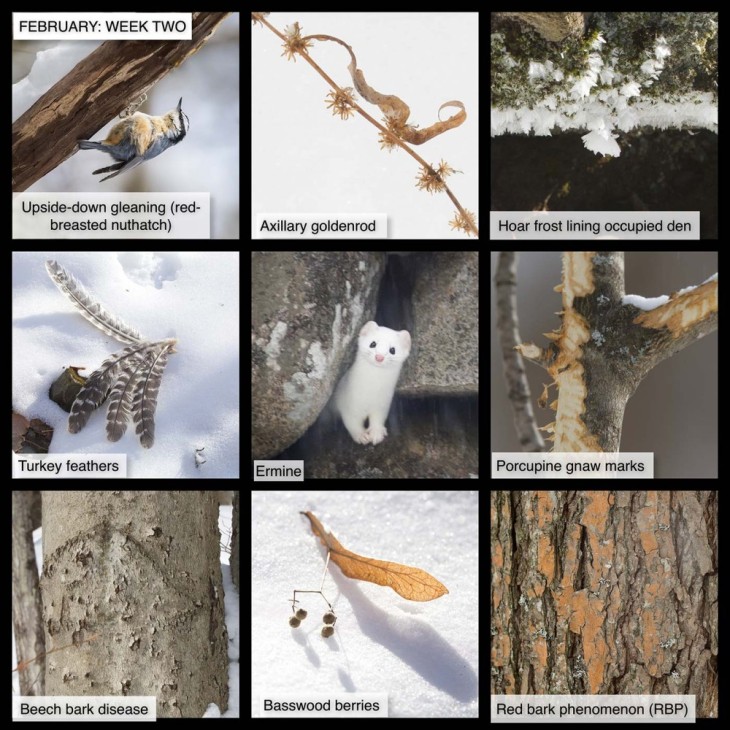This Week in the Woods we watched a nuthatch seem to defy gravity while gleaning bugs upside-down, on the underside of an almost-horizontal branch, and it occurred to us that strong claws and a bracing tail are especially valuable traits in winter. While the top surfaces of most large branches are thickly covered in snow right now, their undersides are still accessible hunting grounds. This article from the Hitchcock Center for the Environment at Hampshire College describes nuthatches’ remarkable feet, which are “relatively large and powerful for a small bird,” with narrow claws that enable them to “find a grip in tiny bark crevasses.”
The dried stems of axillary goldenrod (also called blue-stem goldenrod), spangled with the flower-like remnants of seedheads, are still visible sticking out from the snow. Unlike its sun-loving cousins that crowd the meadows, this species thrives in the woods, and it often grows singly or in groups of just a few plants. Here’s a species profile from The Native Plant Trust.
At the entrance of an occupied den, you may find hoar frost rimming the edges. This may have been formed, as in this photo of a porcupine den entrance, by the warm breaths of an animal rising into the colder, drier outside air. Here’s an explanation of various types of ice formations by Audrey Clark in a 2014 “Landscape Confidential” column for Vermont Digger, including this description of hoar frost on animal dens: “you might find these filigreed shelters on a morning wander through the woods, and when you do, you are in the delightful position of knowing a sleeping animal is likely just a few feet away.”
February is an especially difficult month to be a wild turkey. As noted in this Outside Story essay by Carolyn Lorié, the birds can dig through a maximum depth of about one foot of packed snow, but only about 6 inches of the fluffy stuff. Winter rations – at least from natural sources – are meager; they “survive on mosses, buds, seeds and fern spores.” And if all that (and intense cold) weren’t challenging enough, there are many hungry predators out there. We found coyote tracks next to an abundance of turkey feathers.
Last week, a reader in Rochester, Vermont, sent us several photos of an ermine, which prompted us to share an image from a few winters ago: Tig Tillinghast took this photo of a weasel hunting mice in a stone wall in Thetford. Ermine is an alternate name for a short-tailed weasel, which is also called a stoat. However, long-tailed weasels also grow white coats in winter and are also commonly called ermine when they’re wearing winter white. The two species are very hard to tell apart, especially because you rarely see one for more than a few seconds. They spend most of their time out of sight, hunting mice and other small creatures in tunnels. Here’s a link to an Outside Story describing how the Ice Age influenced their body shape and fast burning metabolism.
If you find what at first glance looks like beaver-gnawed bark up in a tree, you’ve probably discovered porcupine feeding sign. As Susan Shea notes in this Outside Story essay, in winter, porcupines lose body fat, but stave off starvation by feeding on woody materials. They have a caecum – “a sac at the junction of the small and large intestines” – which contains bacteria that break down plant fiber and makes it digestible. Shea’s essay also describes how porcupines’ spring and summer diets lead to metabolic imbalances and salt cravings.
Beech bark disease doesn’t infect every beech, but it has run rampant through the forest, leaving stands of dead and weakened trees with disfigured, puckered bark, and fewer mature trees that can produce nuts for bears and other wildlife. In this Outside Story essay, Joe Rankin explains that the disease is caused by a combination of invasive species: a scale insect, and two closely related fungi. As Rankin notes, one of the main ways that beech bark disease spreads over long distances, is by people moving firewood. One way to help beech is to leave mature trees that show some genetic resistance to infection, so that they can reproduce.
We noted basswood’s bright red buds in this late December post. You may also find clusters of basswood berries on the snow, shaken down by the wind. As Mary Holland notes in this post on her “Naturally Curious” website, a specialized leaf “aids in the wind dispersal of the fruit.”
Finally, we have been finding weird rusty orange patches on hemlocks and wondering what they were. It turns out that this discoloration is called red bark phenomenon (RBP), and it’s caused by green algae that contain orange-red pigments. RBP is a relatively new phenomenon (or, maybe, newly noticed phenomenon) that appears to be spreading in the Northeast and may be related to climate change. Here’s an overview from The Connecticut Agricultural Experiment Station.
Our thanks to The Bailey Charitable Foundation and the Frank and Brinna Sands Foundation for helping to support this series.
In this difficult period, many of us find joy in observing local nature, and many families are seeking outdoor enrichment opportunities for children. Here are nine photographs taken this past week, most within 15 miles of the Northern Woodlands office in Lyme, New Hampshire. We hope you enjoy using this grid as a prompt for your own explorations, or as the basis for a game of family forest tic-tac-toe.
What are you seeing in the woods this week? Share your images with us on Facebook, or submit a special photo for possible inclusion in our monthly online Reader Photo Gallery.


